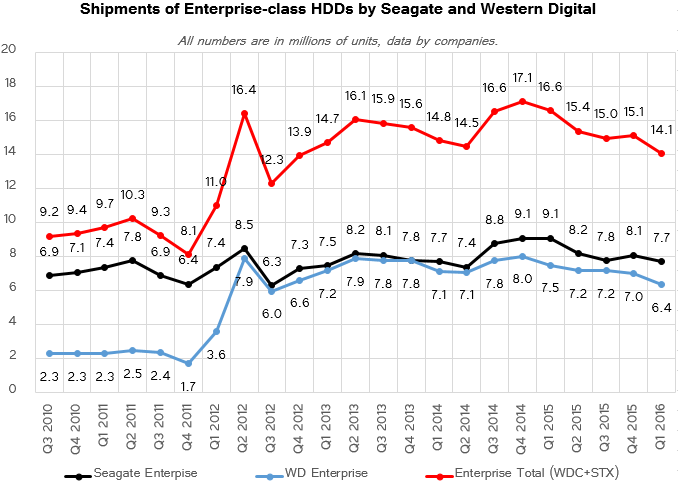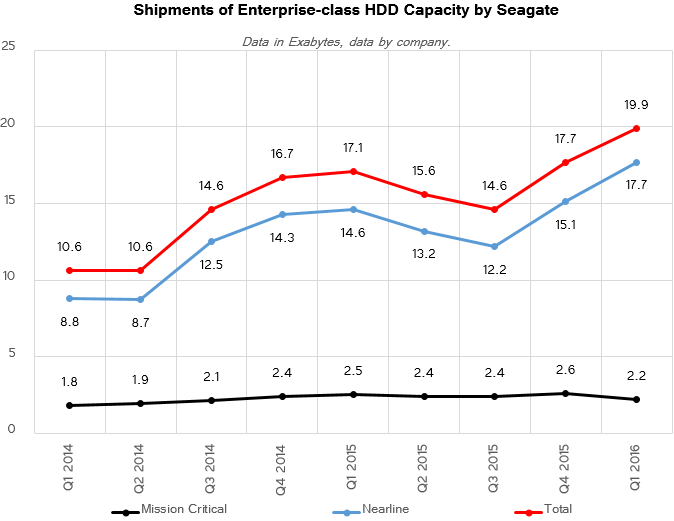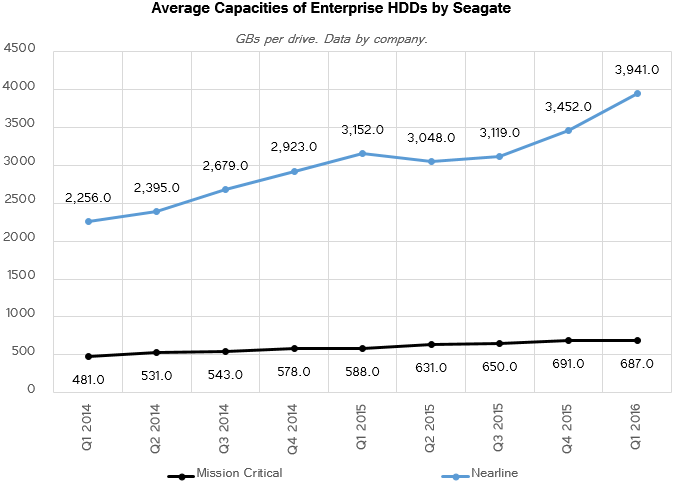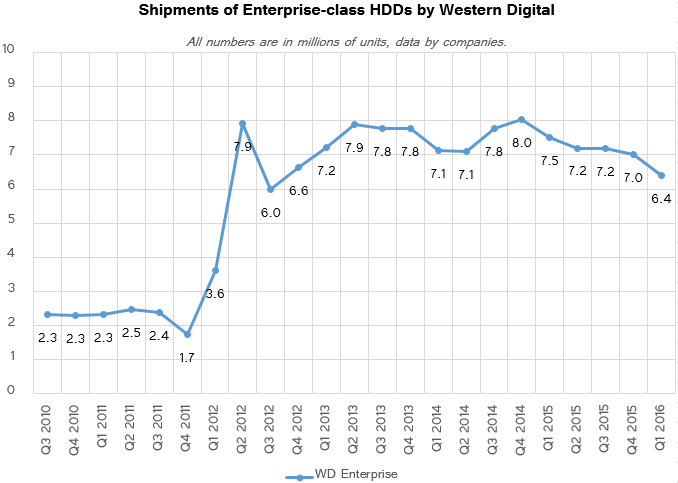Market Views: HDD Shipments Down 20% in Q1 2016, Hit Multi-Year Low
by Anton Shilov on May 12, 2016 8:00 AM ESTUnit Sales of Enterprise HDDs Decline, But There Is a Catch
Enterprise hard disk drives are arguably the most important and lucrative part of HDD makers’ business these days. Firstly, such drives have to use many leading-edge technologies in order to demonstrate very high performance, or offer very high capacities. Secondly, they are not shipped in huge volumes, but they are sold with huge premium because of the technologies as well as extended reliability. Finally, since many client devices no longer have HDDs, but still have to store files elsewhere, their data ends up in the cloud and stored on various datacenter-class HDDs. Basically, even if an HDD maker fails to sell a $50 drive for a low-end laptop, the data from that laptop will eventually be stored on a $300 - $600 nearline drive in a data center, compensating missed revenue to the HDD producer.
There are two types of enterprise-class hard drives:
- High-performance HDDs for mission-critical storage that feature 10K or 15K spindle speeds as well as SAS interface. Such drives compete against SSDs these days and their volumes are slowly declining. This trend has been ongoing for years now and hard drive makers perfectly understand it. Seagate, Toshiba and Western Digital also offer high-end mission critical SSDs with SAS interface to their customers and eventually the portfolio of such solid-state storage devices will only expand.
- Another type of enterprise HDDs are nearline (near online) drives that are used to store various data in data centers. Some of such drives are for cold archives, which are rarely accessed and are hardly ever modified. Such HDDs have 5400 RPM-class spindle speed and their main purpose is to store as much data as possible and at the lowest cost. Other drives are used to store frequently accessed and modified data, which is why they feature 7200 RPM spindle speed and various methods to improve their performance. These drives can be filled with helium to maximize storage space (allowing a reduced platter gap) and keep power consumption down to minimize TCO. Usage of nearline HDDs has been increasing in the recent years. More importantly, their capacities have been growing very rapidly.
It is very important to distinguish between the two types of enterprise-class hard drives not only because they are completely different from a technology point of view, but also because their market dynamics are poles apart. Unfortunately, until this quarter neither of HDD makers disclosed sales of mission critical and nearline drives separately, but only reported the number of enterprise-class HDDs sold. This quarter, Seagate published more or less precise details about its enterprise drives and their dynamics, which we will analyze below. In the meantime, let’s have a look at the shipments of both leading enterprise HDD suppliers.
Based on the numbers from Seagate and Western Digital, sales of enterprise-class hard drives from these two manufacturers declined to 14.09 million units in Q1 2016, which is 15% lower compared to the first quarter last year. Seagate remained the largest supplier of enterprise drives with 7.7 million units sold (down 15.4% YoY), whereas Western Digital supplied 6.39 million of enterprise hard disks (down 15% YoY). Toshiba also has a portfolio of high-end drives for servers, but while it has many products with a SAS interface, it does not participate in the high-end of the nearline market due to lack of 8 TB and 10 TB HDDs in its lineup.
Out of 7.7 million enterprise drives that Seagate shipped in the first quarter, 4.5 million HDDs were for nearline storage applications, whereas 3.2 million HDDs were designed for mission-critical apps.
Shipments of Seagate’s nearline HDDs were down 4.3% compared to the first quarter of 2015, but were slightly up sequentially. The company claims that it expected demand for such drives to be significantly weaker, which is why it could not even satisfy all the demand. During the quarter, Seagate ramped up production of its 8 TB HDD lineup and significantly increased shipments of such drives compared to the previous quarter, however, it could not meet all the demand. The company also supplied a large volume of qualification units of its 10 TB helium-filled hard drives aimed at the highest-end of the cloud market. Due to the 7200 RPM spindle speed and advanced caching sub-system, Seagate’s Enterprise Capacity 3.5 (Helium) 10 TB hard drive is among the fastest in the company’s lineup, challenging even 15K mission-critical drives when it comes to sustained transfer rates (of course, those small drives still have a lot of other advantages, including considerably higher IOPS, significantly lower latency, very high instantaneous transfer rates and so on). In April, the company started revenue shipments of its SATA 10 TB HDDs, which further indicates growing demand for such drives.
By contrast, shipments of mission-critical HDDs dropped 13.6% sequentially and 25.6% year-over-year. The company says that approximately 25% out of 3.2 million mission-critical HDDs are 15K drives, which are gradually replaced by SSDs in the data centers. Solid-state storage devices also challenge 10K HDDs, but the manufacturer expects this segment of the market to have a much longer transition horizon. Because of the economic situation and the market shift to SSDs, sales of mission-critical drives were 700K below Seagate’s original forecast in Q1 2016, the company said.
Given the fact that nearline drives have significantly higher capacities than mission critical drives, it is not surprising that they are driving enterprise storage capacities in terms of EB shipments.
Average enterprise HDD sold by Seagate in Q1 2016 could store 3.941 GB of data, up 25% from the first quarter of last year, which is a direct result of growing demand for capacities from various data center customers.
Western Digital does not break down sales of its enterprise HDDs into nearline and mission critical categories, but while the split may be slightly different, market trends affect both companies in the same way. In its conference call with financial analysts, the management of Western Digital confirmed that shipments of the company’s 15K HDDs are declining because many customers replace such HDDs with SSDs and also observed that many 10K HDD deployments begin to adopt SSDs. In addition, the company noted that in Q1 2016 it saw steeper than expected price declines in performance enterprise and capacity enterprise markets. In particular, the company blamed decreased prices of 4 TB and 8 TB nearline HDDs for its lowering gross margins.















116 Comments
View All Comments
nils_ - Monday, May 30, 2016 - link
Is anyone still buying those 15k or even 10k drives?glad2meetu - Friday, May 13, 2016 - link
I think people are waiting to see what comes out of the merger between WD and Sandisk. I am surprised that Seagate did not make a bid late last year for Micron.I think much of the blame for the decline in the PC market in general is due to Intel failing to innovate. The drop in HDD shipments effectively just mirrors the lower number of new computers being shipped. But that may be a bit harsh on Intel and the rest of the PC industry. It has become much more difficult to make a game changing product given the level of excellence found in existing technology. The same can be said for smartphones.
Hard drives may turn around in another couple of years if designers can get hybrid drives to work as intended. Or perhaps 3D XPoint lives up to the hype and changes the market in another few years.
There also is a risk that the cost reduction on SSDs comes back to haunt them. General consumers will just lump all SSDs together or may view them based on brand names. So SSD makers could get hurt if the cheapest SSDs run into more issues for consumers.
avbohemen - Friday, May 13, 2016 - link
With these numbers, I am wondering: does this include disks delivered to the cloud providers (AWS, Azure, Google), Facebook and other big consumers? They are always expanding their datacenters and use a lot of storage, while no one seems to really know how big their "market share" is. Can anyone share some insight in this?Pix2Go - Friday, May 13, 2016 - link
The numbers in the article do include those customers. They typically are the ones using "Enterprise" drives, with some exceptions.As an idea of how many drives they need, consider this random nugget from "the internet":
"The volumes of storage Google needs are insane: as the post notes, YouTube alone requires a petabyte of new storage every single day."
Yep, at least 1000TB a day in new storage requirements. And I'd bet that's a low estimate.
This link doesn't give a solid answer, but gives some ideas about how much data is really out there. https://www.backblaze.com/blog/200-petabytes-of-cu...
revanchrist - Friday, May 13, 2016 - link
Couldn't agreed more with what some already said. The per GB price of HDD will not go further down, it will just stay stagnant. Right now the lowest per GB price is on 3TB and 4TB drives, once you go further up eyeing for 5TB and more, the prices simply rocket sky high. I think in the future, all those 1TB and 2TB drives will go extinct while 5TB and higher prices will drop down to the level of 3TB and 4TB. 1TB and lower storage space belongs to the SSD, and it will happen very soon.StrangerGuy - Friday, May 13, 2016 - link
My educated guess is that costs of HDDs doesn't scale well at the low end since HDD manufacturers still have to build the entire drive assembly minus platters for a 1TB or less HDD while NAND is far more flexible in physical packaging.zodiacfml - Friday, May 13, 2016 - link
LOL. I feel bad for these ageing kings of storage.They have to throw out their cash and apply for some loans to be build a NAND fab. It is the only way to stay relevant for the next 10 to 20 years. SSDs are already eating from the top and bottom of the food chain. The last remaining stronghold of HDDs is cost per GB; but SSDs doesn't have to go there as HDDs didn't replaced Tape drives for cost per GB.
zodiacfml - Friday, May 13, 2016 - link
Edit: Got carried away and forgot WDs acquisition of Sandisk which puts them on track. Seagate, just do it.vivekvs1992 - Saturday, May 14, 2016 - link
Most of the reasons for declining sales are because of steafy decline in the pricing of small to medium capacity ssd, hdd are used for long term storage nowadays and those drives are never below 1tb, personally i have 2 2tb usb hdd, 1 1tb usb hdd and a 2 tb in my build, and 2 more 2 tb beauties are on their way... The thing is many of my friends don't consider that they can add another hard disk without removing the old one in a desktop, another lot of them don't need so m7ch storage and the last lot are unaware of this data expansion methodFriendlyUser - Saturday, May 14, 2016 - link
For a lot of stuff we have gone from "owning" digital libraries to "subscribing". If people had to locally store their netflix content or their Amazon books and their MP3s, the need for space would have grown considerably. With a fast network you can always rely on re-downloading content you want, instead of storing.Also, in my opinion, the industry has stagnated. Price per GB is today similar to what I paid the last time I upgraded my HDs, in 2009. This is unacceptable. I know I would have bought a ton of 2.5" 2TB HDs for backups and the like, but they are still priced at ~$100. Too expensive... Plus, there has been little progress with hybrid HD/SSDs, which would be a great solution for people who don't want to mess with multiple drives. In fact, all I see is rebranding the same drive with slightly modified firmware and selling it as "NAS" or "workstation" or "IP camera" or "NAS pro" or "Storage" etc.
They have been milking us for too long. Time to start innovating.